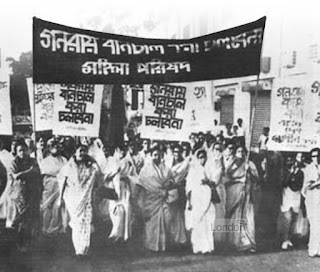Located at a distance of about 2.4 kms from the Karnasubarna railway station(Azimganj-Katwa line, E.R), the archaeological site of Rajbari Danga is an ancient exponent of the Sanatan Hindu civilization.
The very first excavations of this site was conducted under Dr.S.R.Das of Calcutta University in 1962. The total area of the 'Danga' or mound is 503,500 square feet.
The findings included a monastic sealing bearing the legend of the Buddhist Mahavihara - Shri Rakta-mrittika Mahavihara. Other than this several terracotta figurines and ornamental stucco moldings were also found from the site. h
The most significant finding from the excavation might as well be the one with the monastic sealing bearing the legend 'Shri Rakta-mrittikā Mahavaiharik arya bhikshu samghasya' which refers to the the community of venerable monks who resided in the Rakta-mrittikā Mahavihara, that was first mentioned by Xuanzang (Hiuen-Tsang).
The famous Chinese traveler mentioned about a certain 'Lo-to-mo-chi' in his travelogues, which transliterates to 'Rakta-mrittikā Mahavihara'. This Mahavihara was seen by Xuanzang and described as an important centre of learning of Vajrayani Buddhists.
After the excavation of the mound in Jadupur, Chandpara, Karnasubarna,(now known as Rajbari Danga or Raja Karna's Palace) the archaeologists of Calcutta University identified it with the 'Rakta-mrittika Mahavihara'.
The boards put up by ASI reads as follows:
Rajbari Danga also known as Raja Karna's Palace was excavated by the University of Calcutta (1962-82) exposing the remains of a large Buddhist Vihara. On the basis of terracotta seals and sealings the Vihara has been identified with famous 'Rakta Mrittika Mahavihara', described by Hiuen-Tsang in his account. The adjacent mounds and exposed relics are presumed to be the remains of the ancient city of Karnasubarna, the capital of King Sasanka (AD 600-638).


The CU's Department of Archaeology also began their excavation at Jadupur with an intent to identify Karnasubarna, the historic capital city of Shashanka (alt.Sasanka), the king of Gauda, with the mounds and the monuments including the Buddhist monasteries mentioned by Xuanzang in his travelogues.
Image VII:
The excavation revealed five phases of structures. Noteworthy among these were: remains of a platform, two circular basements (probably of a stupa) and lime plastered steps in Phase III and four square structures showing carved brickwork and having pradakshina patha etc.. in Phase V. The structural remains of Phases I and II were represented by brick pavements and those of Phase IV by a wall running over the circular basements of the preceding Phase.


It may be concluded from the archaeological remains of excavated site of Jadupur (Rajbari Danga) that Karnasubarna was in fact an urban centre, just as most capital cities are these days as well. It is also assumable that certain number of rural settlements like Gokarna, Mahalandi and Saktipur came into existence around the capital city, that housed the relatively poorer sections of the society that catered to the daily needs of the citizens of Karnasubarna.
On the basis of the terracotta sealings and figurines, Phase I could be assigned 3rd-4th century CE and Phase III to 6th-7th century CE. The two subsequent phases are said to have belonged to 8th-12th century CE. Some of the seals recovered from the excavation prove the existence of a Buddhist vihara or monastery. Ancient pattern of rows of cells around the central courtyard are noticeable on the design of the monastery.
A sealing excavated from the third phase (Phase III) provides the most weighty indication in the identification of the famous Rakta-mrittikā Mahavihara, described by Hiuen Tsang as 'Lo-to-no-chi' as situated in the urban city of Karnasubarna, 7th century.
Other than the Buddhist sealing(s), several pulchritudinous stucco mouldings of heads, terracotta lamps, a copper chakra, terracotta figurines etc. were excavated from the site and were believed to have been mostly from the Gupta period or 8th century CE at the latest.
Among other findings is pottery in grey ware painted in black with geometric designs e.g. triangles, crosses and waves, checks etc.
The history of this site has been divided in three periods based on the archaeological findings or absence of so, the periods are -
I: The initial stage which is characterized by crude, simplistic pottery without any designs and also the absence of inscribed seals. This period in time may be considered as 2nd-5th century CE.
II:The middle stage uncovers much richer cultural antiquities which are distinguised by inscribed seals. This period is between the 9th and 10th-11th century CE.
III: This is the final stage or the declining period, which not unlike the initial stage can be identified by the absence of seals. The period is between 10th to 13th century.
All Images except Image VII: Deep Biswas © & Sriti O Chetona
Image VII: murshidabad.net










Comments
Post a Comment